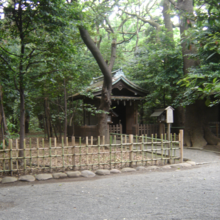Chinreisha (鎮霊
| Chinreisha 鎮霊 | |
|---|---|
 | |
| Religion | |
| Affiliation | Shinto |
| Deity | War dead |
| Type | Imperial Shrine |
| Location | |
| Geographic coordinates | 35°41′36.92″N 139°44′35″E / 35.6935889°N 139.74306°E |
| Architecture | |
| Founder | Fujimaro Tsukuba |
| Date established | 1965 |
The shrine consists of two za, or seats for kami (spirits). One is devoted to all of the Japanese war-dead since 1853 that are not enshrined in Yasukuni Shrine's honden (main shrine). These kami include Japanese men who died fighting against the Imperial Japanese Army in domestic incidents such as the Boshin War. The second za is dedicated to all war dead, regardless of nationality. This is said to include, for example, even the victims affected and killed by Japan during the war. This enshrined kami in the Chinreisha stand in contrast to those enshrined in Yasukuni's honden because they include enemies of Imperial Japan, while Yasukuni Shrine's honden does not.[2]
Controversy
editThe controversy regarding Chinreisha arose with the Japanese Prime minister Shinzo Abe's visit to the Yasukuni shrine on December 26, 2013. However, in an official statement, Abe stated that he "also visited Chinreisha, a remembrance memorial to pray for the souls of all the people regardless of nationalities who lost their lives in the war" and that he "renewed [his] determination before the souls of the war dead to firmly uphold the pledge never to wage a war again", despite the criticism of many media reports that saw the visit as a reminder of Japanese imperialism.[5] In fact, the Sankei Shimbun, a Japanese newspaper, reported that Abe's visit to "not only the Yasukuni shrine, but also the Chinreisha shrine shows his determination to world peace", and criticized the foreign media for only emphasizing the Prime Minister's visit to the Yasukuni shrine, and not shedding enough light on his visit to Chinreisha.[6] Nevertheless, most of the public opinion slanted toward blaming Abe's visit as an offensive act, rather than interpreting it as an act of historical reflection.[citation needed]
References
edit- ^ "Chinreisha". Yasukuni Shrine. Archived from the original on 2008-04-08. Retrieved 2008-05-10.
- ^ a b Breen, John (2005-06-03). "Yasukuni Shrine: Ritual and Memory". Japan Focus. Archived from the original on 2008-04-17. Retrieved 2008-05-10.
- ^ a b Kolstø, Janemil (2007). "Rethinking Yasukuni: From Secular Politics to Religious Sacrifice". University of Bergen. Retrieved 2008-05-10.
- ^ Young-June, Ye (2006). "Chinreisha". JoongAng Daily. Retrieved 2014-04-10.
- ^ Abe, Shinzō (2013). "Statement by Prime Minister Abe - Pledge for everlasting peace -". Prime Minister of Japan and His Cabinet. Retrieved 2014-04-10.
- ^ Cheon, Yesun (2006). "Japan flustered by U.S. Disappointment". Korean Herald. Retrieved 2014-04-10.
